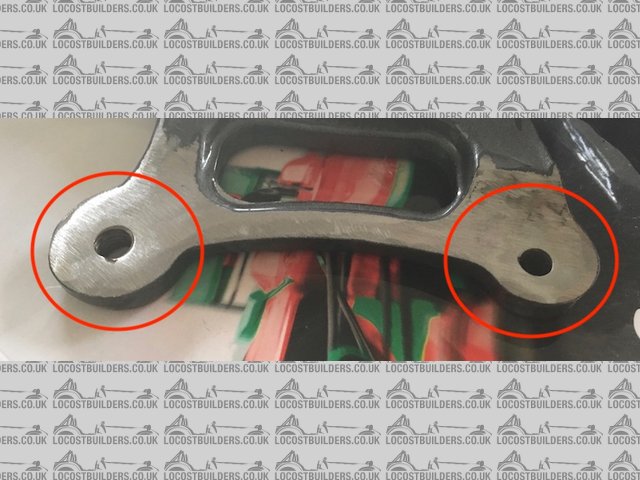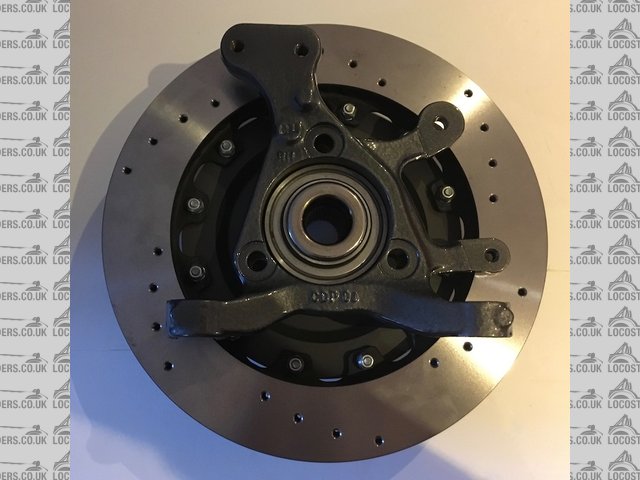
Small Surface Grinding Tips Please
scootz - 27/1/18 at 10:16 AM
Mornin
Does anyone have any hints our tips for getting these two lugs surfaces acceptably flat?
I have a pillar-drill... is anyone aware of there being any drill-bits that machine a flat surface?
Its only for mounting a bracket to take a handbrake spot-caliper, so perfection is not an issue. TBH, my flap-disc grinds are probably perfectly ok
for the purpose, but you know how it goes...

40inches - 27/1/18 at 10:22 AM
I have used my pillar drill as a milling machine, using an end mill cutter and taking small cuts at a time.
Something like this eBay Item
[Edited on 27-1-18 by 40inches]
scootz - 27/1/18 at 10:33 AM
Cheers - was just looking at those.
rusty nuts - 27/1/18 at 12:11 PM
How about using a flat surface ideally a surface plate and a sheet of emery paper to check the surface before any drastic machining?
mark chandler - 27/1/18 at 12:14 PM
If your pillar drill has a taper fit chuck forget it, the sideways force will knock it loose and the mill will drop into your work chewing it up, the
mill will also quickly become loose within the chuck having the same affect, this is why milling machines use collets and drawbars.
You would be better fixing some corse paper to a flat surface ideally glass and rubbing it across this.
From expensive experience, drills are good for drilling mot milling 
[Edited on 27/1/18 by mark chandler]
40inches - 27/1/18 at 12:30 PM
quote:
Originally posted by mark chandler
If your pillar drill has a taper fit chuck forget it, the sideways force will knock it loose and the mill will drop into your work chewing it up, the
mill will also quickly become loose within the chuck having the same affect, this is why milling machines use collets and drawbars.
You would be better fixing some corse paper to a flat surface ideally glass and rubbing it across this.
From expensive experience, drills are good for drilling mot milling 
[Edited on 27/1/18 by mark chandler]
In theory, yes  But I have done a bit of milling on my cheapo Lidl bench drill, with a 1/2" chuck, removing a half mill at a time.
But I have done a bit of milling on my cheapo Lidl bench drill, with a 1/2" chuck, removing a half mill at a time.
The best way is to cut vertically up to a stop, move the work piece along about 5mm, rinse and repeat A bit like engine turning.
A bit like engine turning.
It will need lots of lubricant.
scootz - 27/1/18 at 01:20 PM
Thanks guys... I guess the sanding approach is probably the safest as its not that far away from flat
ReMan - 27/1/18 at 02:44 PM
Alternatively some careful filing with a big file would have them flat and parallel
scootz - 27/1/18 at 05:20 PM
quote:
Originally posted by ReMan
Alternatively some careful filing with a big file would have them flat and parallel
Yup - that would do it! Cheers
fazerruss - 27/1/18 at 06:52 PM
Or take it to someone with a milling machine. I could do it but im probably miles away.
[Edited on 27/1/18 by fazerruss]
scootz - 16/2/18 at 10:13 PM
Just to complete the story - bit the bullet and took it to my local machine shop. Cost a tenner, but its perfect. Now all powder coated!
Thanks for the replies.

40inches - 16/2/18 at 11:11 PM
Brilliant 






Angel Acevedo - 17/2/18 at 12:43 AM
quote:
Originally posted by scootz
.. Cost a tenner, but its perfect. ...
Thanks for the replies.

Locost solution for an expensive problem awaiting to happen..
Well done!
02GF74 - 20/2/18 at 09:01 PM
quote:
Originally posted by 40inches
quote:
Originally posted by mark chandler
If your pillar drill has a taper fit chuck forget it, the sideways force will knock it loose and the mill will drop into your work chewing it up, the
mill will also quickly become loose within the chuck having the same affect, this is why milling machines use collets and drawbars.
You would be better fixing some corse paper to a flat surface ideally glass and rubbing it across this.
From expensive experience, drills are good for drilling mot milling 
[Edited on 27/1/18 by mark chandler]
In theory, yes  But I have done a bit of milling on my cheapo Lidl bench drill, with a 1/2" chuck, removing a half mill at a time.
But I have done a bit of milling on my cheapo Lidl bench drill, with a 1/2" chuck, removing a half mill at a time.
The best way is to cut vertically up to a stop, move the work piece along about 5mm, rinse and repeat A bit like engine turning.
A bit like engine turning.
It will need lots of lubricant.
If it is critical piece, then don't - I've done the same and had the chuck come out and chew the aluminium piece.



 But I have done a bit of milling on my cheapo Lidl bench drill, with a 1/2" chuck, removing a half mill at a time.
But I have done a bit of milling on my cheapo Lidl bench drill, with a 1/2" chuck, removing a half mill at a time.  A bit like engine turning.
A bit like engine turning. 
